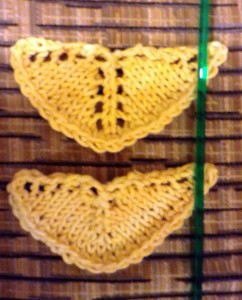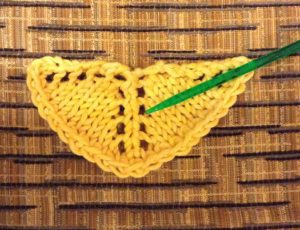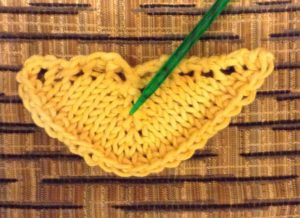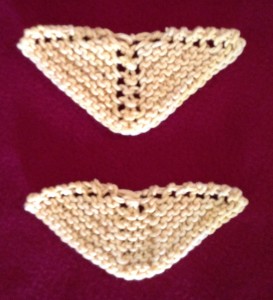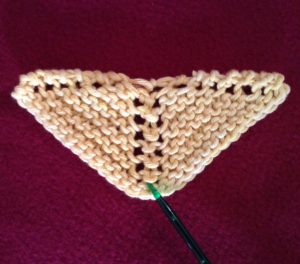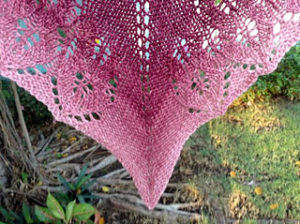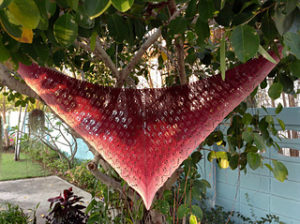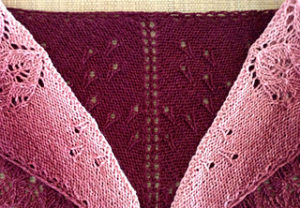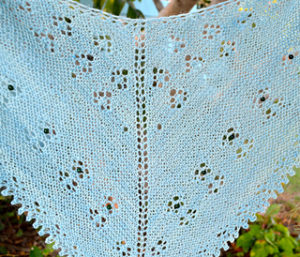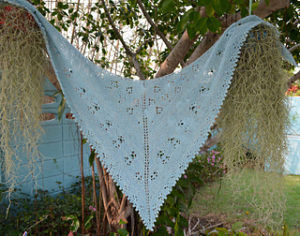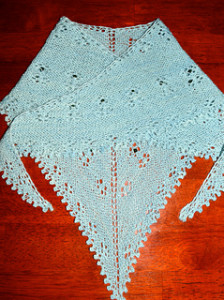When you’re knitting a triangular top-down shawl you have a choice whether to make the increases along the central spine visible or (nearly) invisible. [If you’re knitting in garter stitch, refer to last week’s post on this topic.]
If your design includes some eyelet or lace stitches, you might want to make the spine increases visible to add to the overall open or lace effect. If your pattern doesn’t incorporate lace you might want to make these increases less visible, creating a less interrupted fabric.
Here’s a way to construct a simple triangular, top-down shawl. Whether you’re looking to make the central spine increases visible or invisible, start out like this (abbreviation key at end of instructions):
CO 3 stitches
Row 1: K1, YO, K1, YO, K1 (5 stitches)
Row 2: Purl across
Row 3: K1, YO, K1, YO, PM, K1, PM, YO, K1, YO, K1 (9 stitches)
Row 4: Purl across
For visible central spine increases, continue as follows:
Row 5: K1, YO, K3, YO, (PM) K1, (PM) YO, K3, YO, K1 (13 stitches)
Row 6: Purl across
Row 7: K1, YO, K5, YO, (SM) K1, (SM) YO, K5, YO, K1 (17 stitches)
Row 8: Purl across
Row 9: K1, YO, K7, YO, (SM) K1, (SM) YO, K7, YO, K1 (21 stitches)
and so on…
As you can see, for each odd-numbered row you start with K1, YO, and knit across to the center K stitch, and do a YO on each side of it, slipping the markers to keep them on each side of the central K stitch. YO before the last stitch, K1 (on each right-side row you’ll increase 4 stitches).
You continue this way until the shawl reaches the dimensions you want, and then bind off loosely.
For invisible central spine increases, continues as follows (after the first 4 rows):
Row 5: K1, YO, K3, M1R, (PM) K1, (PM) M1L, K3, YO, K1 (13 stitches)
Row 6: Purl across
Row 7: K1, YO, K5, M1R, (SM) K1, (SM) M1L, K5, YO, K1 (17 stitches)
Row 8: Purl across
Row 9: K1, YO, K7, M1R, (SM) K1, (SM) M1L, K7, YO, K1 (21 stitches)
and so on…
As you can see, for each odd-numbered row you start with K1, YO, and knit across to the stitch before the marker and M1R in that stitch, SM, K1, SM, M1L in the next stitch, knit across until you have 1 stitch left on your left needle, and then YO, K1 (on each right-side row you’ll increase 4 stitches).
Abbreviations:
CO (cast on)
K (knit)
M1(R or L) (knit in the bar between 2 stitches, to increase 1 stitch)
YO (yarn over, to increase 1 stitch)
PM (place marker on needle)
SM (slip marker to other needle)
See my shawl patterns on Ravelry and Craftsy, and some of my hand-knit shawls on Etsy.
Happy knitting!
MikeH

